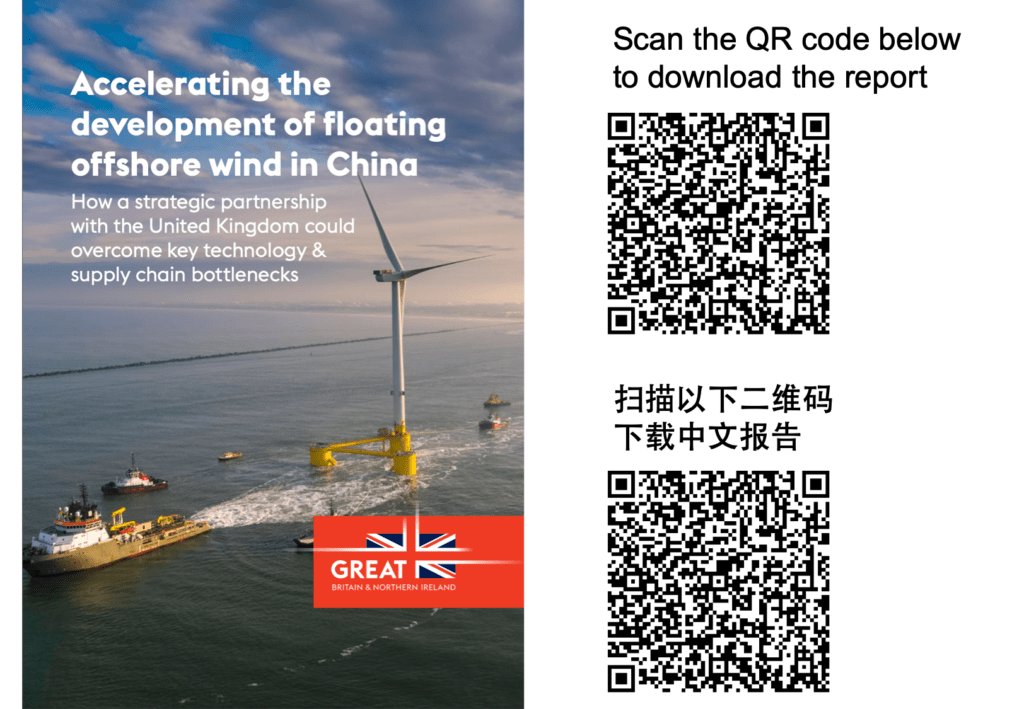During a critical decade for carbon emissions reduction, how can UK and Chinese industries cooperate to accelerate the deployment of floating offshore wind? A new report sheds light on the challenges and opportunities
Floating offshore wind is a key emerging technology that is at an early stage of commercialisation in the UK and Europe. According to the Global Wind Energy Council (GWEC), the technology will triple the size of the addressable global offshore wind market by enabling the installation of wind turbines in water deeper than 60 metres. This has huge potential to increase clean power generation for densely populated coastal areas.
A new UK Government report based on a three-month study by leading energy consultancy Azure International identifies 600GW technical potential for floating offshore wind in China, showing the enormous potential for China to become a future leader in the sector. Harnessing the potential of floating wind power could support China to meet its carbon peaking and carbon reduction targets.
“The UK and China have an established relationship on offshore wind, reaching the eighth annual session of the bilateral Offshore Wind Industry Advisory Group in 2022. Over these past eight years, offshore wind has developed from a niche sector to a booming industry, key for the decarbonisation of power grids across the world, and central to international efforts to limit global warming to below 1.5 degrees,” says John Edwards, Her Majesty’s Trade Commissioner for China.
However, the technology has some big challenges ahead in order to scale, including a lack of special power tariff subsidies and a supply chain that is still largely focused on fixed-bottom wind farms.
China has the world’s largest installed capacity of fixed-bottom offshore wind, at 26.4GW, and a strong armada of tier one manufacturers, supplying turbines, blades, cables, towers and monopiles for projects around the world. Currently, floating offshore wind is at an early stage, with two demonstration projects in the construction phase and six in the design phase. The first floating offshore wind project in China, developed by China Three Gorges Group, went into operation off the coast of Guangdong in 2021. The report identifies 16 sites across four provinces in south-eastern China that have good potential for floating offshore wind, a finding affirmed by the chairman of the China Renewable Energy Engineering Institute (CREEI), Peng Cheng: “China’s expansive coastline and deep waters have a high potential for the development of offshore wind power. In deep waters, floating offshore wind is one of the main methods for development.”
With the largest installed capacity of floating offshore wind in the world, the UK could be China’s key partner to support this development. The UK has two commercial floating wind farms and an ambition to install 5GW by 2030. That ambition is backed by an established pipeline of 11 allocated floating offshore wind commercial sites, totalling 15GW capacity. A thriving ecosystem of universities, innovation hubs, manufacturers and ports are supporting the industry’s development, and the UK Government has ring-fenced £160 million of funding.
The report demonstrates how a strategic partnership between China and the UK could overcome key technology and supply chain bottlenecks to accelerate floating offshore wind deployment. As Li Dan, Executive Secretary-General of the China Renewable Energy Industry Association, comments, “[China and the UK] can draw on China’s relatively complete supply chain system and the UK’s relatively advanced technological capabilities in certain fields to lower the unit investment cost and LCOE of floating offshore wind.” The report also recommends key R&D topics for China and the UK to undertake in order to reduce the cost of floating wind technology, including mooring optimisation, cable dynamics, modular systems, and how to minimise environmental impact. Alongside the potential commercial and technological benefits, this creates the opportunity for greater exchange and understanding between engineers in both countries.
“Offshore wind has developed from a niche sector to a booming industry. I hope that we can implement the report’s recommendations together to develop better technology, a larger global capacity, and stronger industry-to-industry relationships,” says Edwards. Cooperation with the UK to co-develop commercial floating wind projects in China also has the potential to create components, systems, and processes with high export potential. China could have a key opportunity to capture and supply the international market by providing the necessary products to accelerate floating wind deployment around the world.





